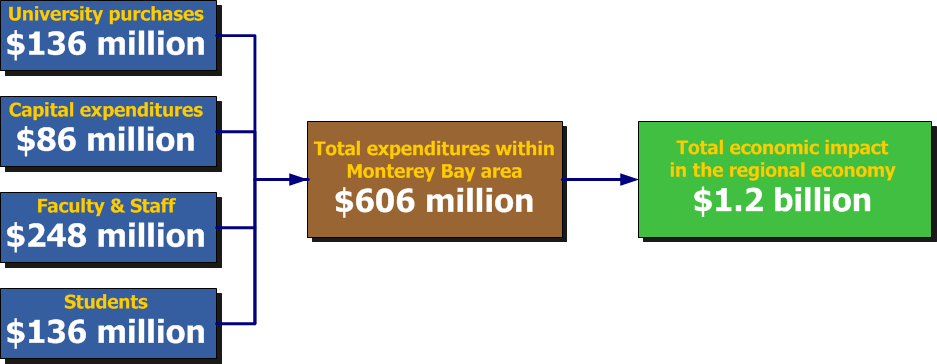Overview
The economic contribution of UC Santa Cruz
A growing investment in the Santa Cruz Community and the Monterey Bay Area
Highlights
- Every dollar spent by UC Santa Cruz grows to return more than $2.50 in the Monterey Bay Area.
- UC Santa Cruz contributed at least $1.2 billion to the local economy.
- UC Santa Cruz economic activity generated an additional 15,760 local jobs in 2009-10.
- UC Santa Cruz is the largest employer in Santa Cruz County.
Introduction
In its first 45 years, UCSC has been, through its direct spending, an engine for positive economic growth in the Santa Cruz and Monterey Bay regions. In addition to the dollars spent directly by the University, its students, and employees, there is additional economic benefit derived from the knowledge and discoveries that result from campus research. The talented faculty and students attracted by the campus are engaged citizens and also make cultural and service contributions that enhance the quality of life.
The educational excellence and leadership of UCSC is recognized in the U.S. News & World Report survey, which ranked UCSC 29th nationally among public doctoral universities in 2011. The campus faculty includes two of the University of California’s honored University Professors, 24 members of the American Academy of Arts and Sciences, 14 members of the National Academy of Sciences, and 33 members of the American Association for the Advancement of Science.
Sources for campus funds
Nearly all of the University's budget comes into Santa Cruz County from outside the local area—in the form of, for example, State of California appropriations; extramural support—including Federal contracts and grants, private gifts, and endowments; and student tuition and fees. Thus, much of the money spent by the University represents new money to the community and generates new economic activity within the region that would otherwise not have occurred without the presence of the campus.

Of UCSC's $530 million operating budget in 2009-10, 26 percent came from the State, 27 percent came from student tuition and fees, 29 percent came from governmental contracts and grants and from private gifts and endowments, and 18 percent from other sources. (UCSC's fiscal year runs from July 1 through June 30.)
Spending
The University's operating expenditures fall into two major categories: (i) salaries and benefits for its employees (nearly 60 percent of the total) and (ii) those related to purchases of supplies, equipment, and services and to new construction. UC Santa Cruz is the largest single employer in Santa Cruz County.

UC Santa Cruz Economic Contributions, 2009-10
Actual spending by the university, and its employees and students, totaled $606 million; when calculated by an economic multiplier formula, the total jumps to $1.2 billion for the Monterey Bay Area, and close to $1.5 billion state-wide. The economic multiplier is a calculation used by economists to measure not just the actual dollars spent, but the value of those dollars when they are spent again. In essence, the economic multiplier shows the ripple effect of each dollar spent in an economy.
Purchases made by university employees play a major role in the economic vitality of the community. According to an analysis prepared by Economic and Planning Systems, Inc. (EPS) on behalf of the University, UCSC faculty and staff spent over $248 million on purchases and services in the Monterey Bay area, including payments for health, life, dental, and vision insurance. Student expenditures (after payment of university fees) totaled $136 million locally.
The campus also uses outside funding (such as research grants) to purchase local goods and services. In 2009-10, the university spent about $136 million for supplies, equipment, and services. Expenditures for capital items (including campus construction) exceeded $86 million.
The campus also attracted an estimated 220,000 visitors in 2009-10—prospective students and their parents; guests of faculty, staff, and students; summer session students; and others attending special events. Many of these visitors stay in local hotels, dine in area restaurants, and visit area attractions such as the Boardwalk.
Job creation
UC Santa Cruz employed 7,300 full- and part-time people, including 3,500 student workers (in October 2010). However, because of the economic multiplier or ripple effects, spending by the campus generated an estimated 17,000 jobs statewide—most of those here in the Monterey Bay area. Because the State of California’s spending on UC is heavily supplemented or “leveraged” by a variety of other non-State funding sources (e.g., federal and private/nonprofit research grants), it produces a relatively high return-on-investment. EPS estimates that every $1 that the California taxpayer invests in UC and its students results in $13.80 in economic output throughout the State. In addition, graduate education and research at UC have long fueled innovation and economic development in California. EPS estimates that 1 in 46 jobs in California is the result of UC operations and spending by faculty, staff, students and retirees.
In addition to the economic impact shown in the table above, the campus also attracts thousands of visitors each year—prospective students and their parents; guests of faculty, staff, and students; summer session students; and others attending special events—all of whom are important to local tourism.
